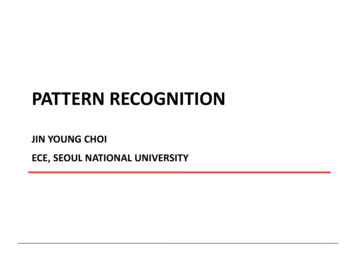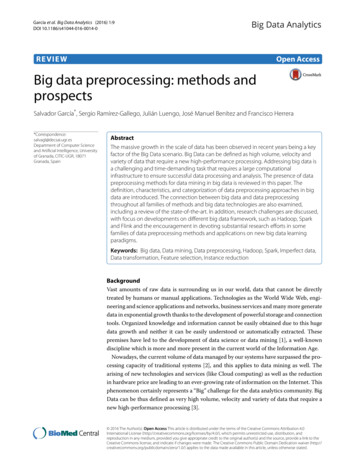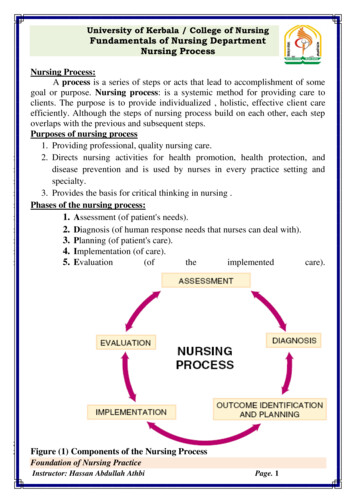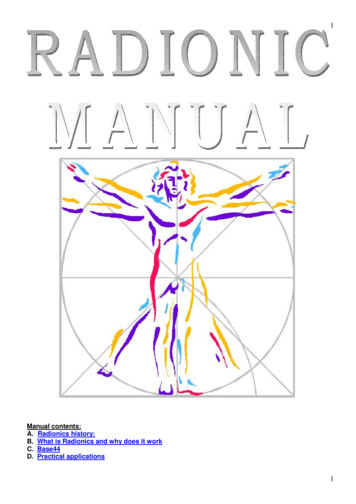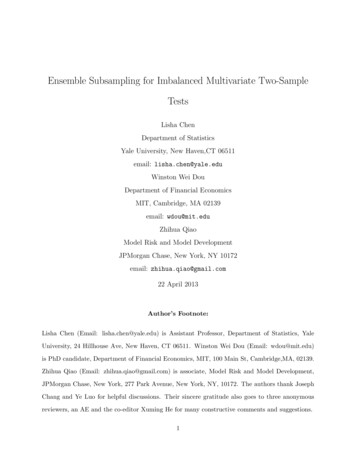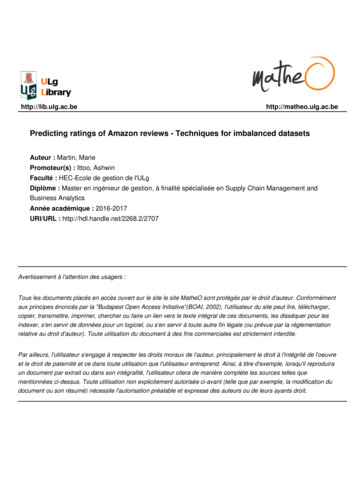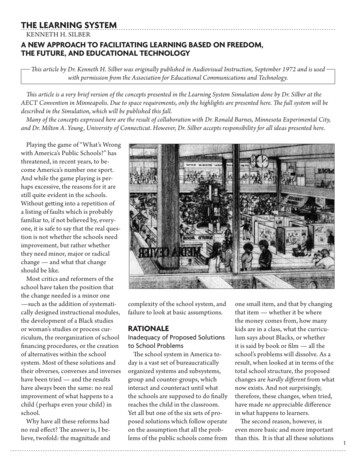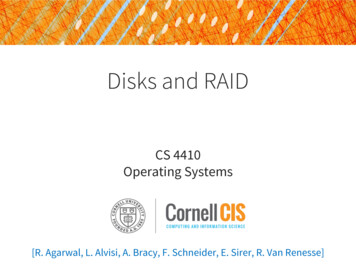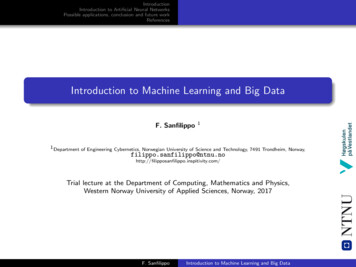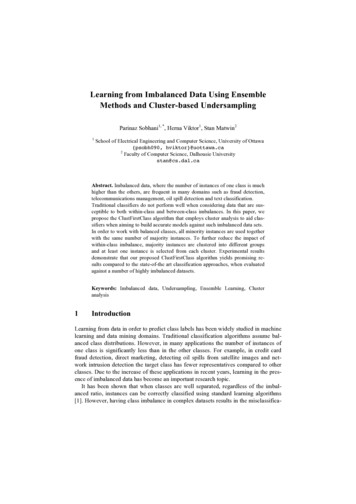
Transcription
Learning from Imbalanced Data Using EnsembleMethods and Cluster-based UndersamplingParinaz Sobhani1, *, Herna Viktor1, Stan Matwin21School of Electrical Engineering and Computer Science, University of Ottawa{psobh090, hviktor}@uottawa.ca2Faculty of Computer Science, Dalhousie Universitystan@cs.dal.caAbstract. Imbalanced data, where the number of instances of one class is muchhigher than the others, are frequent in many domains such as fraud detection,telecommunications management, oil spill detection and text classification.Traditional classifiers do not perform well when considering data that are susceptible to both within-class and between-class imbalances. In this paper, wepropose the ClustFirstClass algorithm that employs cluster analysis to aid classifiers when aiming to build accurate models against such imbalanced data sets.In order to work with balanced classes, all minority instances are used togetherwith the same number of majority instances. To further reduce the impact ofwithin-class imbalance, majority instances are clustered into different groupsand at least one instance is selected from each cluster. Experimental resultsdemonstrate that our proposed ClustFirstClass algorithm yields promising results compared to the state-of-the art classification approaches, when evaluatedagainst a number of highly imbalanced datasets.Keywords: Imbalanced data, Undersampling, Ensemble Learning, Clusteranalysis1IntroductionLearning from data in order to predict class labels has been widely studied in machinelearning and data mining domains. Traditional classification algorithms assume balanced class distributions. However, in many applications the number of instances ofone class is significantly less than in the other classes. For example, in credit cardfraud detection, direct marketing, detecting oil spills from satellite images and network intrusion detection the target class has fewer representatives compared to otherclasses. Due to the increase of these applications in recent years, learning in the presence of imbalanced data has become an important research topic.It has been shown that when classes are well separated, regardless of the imbalanced ratio, instances can be correctly classified using standard learning algorithms[1]. However, having class imbalance in complex datasets results in the misclassifica-
tion of data, especially of the minority class instances. Such data complexity coversissues such as overlapping classes, within-class imbalance, outliers and noise.Within-class imbalance occurs when a class is scattered into smaller sub-parts representing separate subconcepts [2]. Subconcepts with limited representatives arecalled “small disjuncts” [2]. Classification algorithms are often not able to learn smalldisjuncts. This problem is more severe in the case of undersampling techniques. Thisis due to the fact that the probability of randomly selecting an instance from smalldisjuncts within the majority class is very low. These regions may thus remain unlearned. The main contribution of this paper is to address this issue by employingclustering techniques.In this paper, a novel binary-class classification algorithm is suggested to handledata imbalance, mainly within-class and between-class imbalance. Our ClustFirstClass technique employs clustering techniques and ensemble learning methods toaddress these issues. In order to obtain balanced classes, all minority instances areused together with the same number of majority instances, as obtained after applyinga clustering algorithm. That is, to reduce the impact of within-class imbalance majority instances are clustered into different groups and at least one instance is selectedfrom each cluster. In our ClustFirstClass method, several classifiers are trained withthe above procedure and combined to produce the final prediction results. By deploying several classifiers rather than a single classifier, information loss due to neglectingpart of majority instances is reduced.The rest of this paper is organized as follows. The next section presents relatedworks for classification of imbalanced data. We detail our ClustFirstClass method inSection 3. Section 4 describes the setup and results of implementing and comparing ofour algorithm with other state-of-the-art methods. Finally, Section 5 concludes thepaper.2Related WorkImbalanced class distribution may be handled by two main approaches. Firstly, thereare sampling techniques that attempt to handle imbalance at data level by resamplingoriginal data to provide balanced classes. The second category of algorithms modifiesexisting classification methods at algorithmic level to be appropriate for imbalancedsetting [3]. Most of the previous works in the literature have been concentrated onfinding a solution at the data level.Sampling techniques can improve classification performance in most imbalancedapplications [4]. These approaches are broadly categorized as undersampling andoversampling techniques. The main idea behind undersampling techniques is to reduce the number of majority class instances. Oversampling methods, on the otherhand, attempt to increase the number of minority examples to have balanced datasets.Both simple under- and oversampling approaches suffer from their own drawbacks.The main drawback of undersampling techniques is information loss due to neglectingpart of majority instances. A major drawback of oversampling methods is the risk ofoverfitting, as a consequence of repeating minority examples many times.
In recent years, using ensemble approaches for imbalanced data classification hasdrawn lots of interest in the literature. Since ensemble algorithms are naturally designed to improve accuracy, applying them solely on imbalanced data does not solvethe problem. However, their combination with other techniques such as under- andoversampling methods has shown promising results [16]. In [13] by integrating bagging with undersampling techniques better results are obtained. In [5], an ensemblealgorithm, namely EasyEnsemble, has been introduced to reduce information loss.EasyEnsemble obtains different subsets by independently sampling from majorityinstances and combines each subset with all the minority instances to train base classifiers of the ensemble learner. In another work that extends bagging ensembles [20],the authors propose the use of so-called roughly balanced (RB) bagging ensembles,where the number of instances from the classes is averaged over all the subsets. Adrawback of these bagging approaches is that they choose instances randomly, i.e.without considering the distribution of the data within each class while in [12] it hasshown that one of the key factor in the success of ensemble method is majority instance selection strategy.Cluster-based sampling techniques have been used to improve the classification ofimbalanced data. Specifically, they have introduced “an added element of flexibility”that has not been offered by most of previous algorithms [4]. Jo et al. have suggesteda cluster-based oversampling method to address both within-class and between-classimbalance [2]. In this algorithm, the K-means clustering algorithm is independentlyapplied on minority and majority instances. Subsequently, each cluster is oversampledsuch that all clusters of the same class have an equal number of instances and all classes have the same size. The drawback of this algorithm, like most of oversamplingalgorithms, is the potential of overfitting the training data. In this paper, we also attempt to handle within and between class imbalances by employing clustering techniques. However, in our work we use undersampling techniques instead of oversampling, in order to avoid this drawback. In [6], a set of undersampling methodsbased on clustering (SBC) is suggested. In their approach, all the training data areclustered in different groups and based on the ratio of majority to minority samples ineach cluster, a number of majority instances are selected from each cluster. Finally,all minority instances are combined with selected majority examples to train a classifier. Our approach is completely different as we only cluster majority instances andthe same number of majority instances is selected from all clusters.3Proposed AlgorithmIn this section, a new cluster-based under-sampling approach, called ClustFirstClass,is presented for binary classification. However, it can be easily extended to multiclassscenarios. This method is capable of handling between-class imbalance by having thesame number of instances from minority and majority classes and within-class imbalance by focusing on all clusters within a class equally.To have more intuition why clustering is effective for classification of imbalanceddata, consider the given distribution of Figure 1. In this figure, circles represent ma-
jority class instances and squares are instances of minority class. Each of these classescontains several subconcepts. In order to have balanced classes, it follows that eightmajority instances should be selected and combined with minority representatives totrain a classifier. If these instances are randomly chosen, the probability of selectingan instance from region 1 and 2 will be low. Thus, the classifier will have difficultyclassifying instances in these regions correctly. In general, the drawback of randomlyselecting small number of majority class instances is that small disjuncts with lessrepresentative data may remain unlearned. By clustering majority instances in different groups and then selecting at least one instance from each cluster, this problem canbe resolved.Fig. 1. A dataset with between and within class imbalance3.1Under-sampling based on clustering and K-nearest neighborIn this group of methods, a single classifier is trained using all minority instances andequal number of majority instances. In order to have a representative from all subconcepts of the majority class, these instances are clustered into disjoint groups and oneinstance is selected from each cluster. However, rather than blindly selecting an instance, we attempt to choose more informative representative from each cluster. Principally, the difference between methods of this group is how these samples are selected from each cluster.One of the most common representatives of a cluster is the cluster centroid. In ourfirst suggested algorithm, clusters’ centroids are combined with minority instances totrain a classifier. For the rest of our methods, we follow the same procedures as presented in [7] to choose one instance from each cluster based on K-nearest neighbor(KNN) classifier. These three methods are widely used and have shown to producegood results in many domains [7]. Firstly, NearMiss1 selects the majority examplefrom each cluster that has the minimum average distance to the three closest minorityinstances, as compared to the other examples in its cluster. In the same way, in NearMiss2, the example with minimum distance to its three farthest minority instances is
chosen. The third alternative involves choosing the instance from each cluster that hasthe “most distance” to its three minority nearest neighbors.3.2Under-sampling based on clustering and ensemble learningThe main drawback of most undersampling methods, including those methods suggested earlier in this paper, is the information loss caused by considering a small setof majority instances and subsequently neglecting other majority class instances thatmay contain useful information for classification. Ensemble methods can solve thisproblem by using more instances of the majority class in different base learners [4]. Inour proposed ensemble method, several classifiers are trained and combined to generate the final results. Each classifier is trained by selecting at least one sample fromeach cluster. Recall that the advantage of using cluster-based sampling instead ofblind sampling is that all subconcepts are represented in training data. Therefore, noneof them remains “unlearned”.The proposed ensemble algorithm is developed by training several base classifiersthat are combined using a weighted majority voting combination rule, where theweight of each classifier is proportional to inverse of its error on the whole trainingset. Each learner is trained using Dmin, whole minority instances, and Emaj, selectedmajority instances, where Emaj contains Dmin /k randomly selected instances fromeach cluster. By assigning a value between 1 and Dmin to k, a balanced learner isobtained, while ensuring that instances from all subconcepts of majority class participate in training a classifier. The following pseudo-code describes our proposed algorithm in more details.ClusFirstClass AlgorithmInput: D {(xi, yi)}, i 1, , NDivide D into Dmin and DmajCluster Dmaj into k partition Pi i 1, ,kFor each classifier Cj j 1, ,mFor each cluster PiEmaj Randomly selected Dmin /k instances of PiEnd ForTr Emaj DminTrain Cj using Trej Error rate of Cj on DWj log (1/ ej)End ForOutput: C!"# % x argmax! !!!! W! C! x c4Experiments and ResultsIn this section, first, common evaluation metrics for imbalanced data are introducedand then datasets and experimental setting that are used in this paper are presented.
Finally, our proposed algorithms are evaluated and compared with several state-ofthe-art methods.4.1Evaluation CriteriaFor imbalanced datasets, it is not sufficient to evaluate the performance of the classifier by only considering the overall accuracy [4]. In this paper, following other researchers, we use the F-measure and G-mean measures to evaluate the performance ofdifferent algorithms. Both F-measure and G-mean are functions of confusion matrix, apopular representation of the classifier performance. The F-measure considers bothprecision and recall at the same time while G-mean combines sensitivity and specificity as an evaluation metric.4.2Datasets and Experimental SettingsIn this section, first artificial and real datasets for our experiments are introduced andsubsequently more details about our experimental settings are described. Our proposed algorithm is particularly effective in presence of within and between class imbalances. To evaluate efficiency of our proposed method, it is applied on two sets ofartificial datasets with varying degree of between class imbalances and different number of subconcepts. Furthermore, it is tested on real datasets from UCI repository [9].Table 1. Description of uni-dimensional artificial tasetSize8040016008040016000-0.25 4208010502000.25-506834012805025010000.50-0.75 0.6750.750.8751 - - - 2510023119421891102To create artificial datasets with varying degree of imbalance ratio and the number ofsubconcepts, we follow the same procedure as [1] with one difference that majorityclass as well as minority class has small disjuncts. In our artificial datasets, majority
class instances have at least one small disjuncts. As in [1], three parameters are considered to create different datasets: dataset size, number of subconcepts and the imbalance ratio. Two sets of artificial datasets one uni-dimensional and the other multidimensional are generated.Table 1 describes the number and label of data in each subconcept in unidimensional space. Data are distributed uniformly in intervals. For datasets with eightsubconcepts, one of the intervals of majority data (negative label) is selected randomly as small disjunct with less representative data. Multi-dimensional datasets have fivedimensions and we have the same clusters as [1]. The definition of subconcepts anddataset sizes is the same as described datasets in table 1.In [8], a benchmark of highly imbalanced datasets from UCI repository is collectedand prepared for binary classification task. We selected 8 datasets with wide range ofimbalance ratios (from 9 to 130), sizes (from 300 to over 4000 examples) and attributes (purely nominal, purely continuous and mixed) from this benchmark. Table 2shows the summary of these datasets. Here, all the nominal features have been converted to binary values with multiple dimensions. Following [8], datasets that hadmore than two classes have been modified by selecting one target class as positive,and considering the rest of the classes as being negative. Continuous features havebeen normalized to avoid the effect of different scales for different attributes especially for our distance measurements.Table 2. The Summary of Datasets. In Features, N and C represent Nominal and anceLibras MoveArrhythmiaCar 367CimU1:953193CLRS 441:116254NBalance1:1236090CPositive1:1445273N, 206CClass 061:1717286NVery good1:2514848CME21:2841771N, 7CRing 191:130All algorithms are implemented in the MATLAB framework. In all experiments, 5fold stratified cross validation is applied. 5-fold cross validation is chosen due to limited number of minority instances in most datasets. The whole process of cross validation is repeated ten times and the final outputs are the means of these ten runs.Decision trees have been commonly used in several imbalanced problems as a baseclassifier [5], [11], [12]. In this paper, the CART algorithm [10] is chosen as baselearning method for our experiments.We applied the K-means clustering algorithm to partition majority instances. However, instead of using the Euclidean distance to find similarity of instances, the L1norm is used. The advantage of using the L1-norm over the Euclidean distance is that
it is less sensitive to outliers in the data. Also, the probability of having a singletonpartition for outliers is less than Euclidean distance [14]. Further, it has been shownthat using the L1- norm is more suitable when learning in a setting which is susceptible to class imbalance, especially where the number of features is higher that thenumber of minority class examples [18].4.3Results and AnalysesIn the first experiment, we evaluate the performance of our proposed single classifiers. Table 3 demonstrates the results of applying these methods on our real datasetsand comparing them in terms of F-measure and G-mean. The results show that NearMiss1 has better performance compared to other classifiers and the classifier that usesthe centroids as cluster representative has significantly lower F-measure and Gmeans. It can be concluded that cluster centroids are not informative for our classification task. In summary, as we expected, single undersampling learner suffers frominformation loss. In the rest of the experiments, we use an ensemble-learning methodinstead of using a single CART classifier.In the next experiment, to evaluate our proposed ensemble classifier ClusFirstClassin different scenarios with different degree of within and between class imbalances, itis applied on artificial datasets. We consider a bagging ensemble learner that choosesrandomly a subset of majority instances to be combined with all minority instances, asthe baseline and compare the performance of this algorithm with our proposed method. The only difference between baseline method and ClusFirstClass is that it choosesmajority instances randomly. It has the same number of base learners and combination rule.Table 3. F-measure and G-mean of proposed single classifiersNearMiss1F-MeasureNearMostMiss2 DistantCentroidNearMiss1G-MeanNearMostMiss2 50.50500.46000.5551Libras 74110.76230.7737Car 76140.76380.6265DatasetCentroidFigure 2 and 3 illustrates the results of applying our proposed method on previously described uni-dimensional and multi-dimensional artificial datasets respectively. Inall 12 scenarios ClusFirstClass is compared to baseline method in terms of F-measure.For all datasets, our proposed method has considerably better performance compared
to baseline. In most cases, as the imbalance ratio and the number of subconcepts increase the difference between our proposed classifier and baseline algorithm becomesmore significant.In the first experiment with proposed single classifiers, we have clustered majorityinstances into k groups using the k-means algorithm, where k Dmin . In experimentson artificial datasets, obviously the number of clusters is equal to the number of subconcepts within the majority class. For the next experiments, in order to compute thenatural number of clusters, different number of k from 1 to Dmin is tested to find theone with the best average Silhouette plot [17].a)In the case of having four subconceptsb)In the case of having eight subconceptsFig. 2. Results of applying our proposed method on previously described uni-dimensionalartificial datasets in terms of F-measureTable 4 shows the results of comparing our proposed undersampling ensemble algorithm based on clustering with another undersampling ensemble method, EasyEnsemble [5] and two cluster-based algorithms, Cluster-based oversampling [2] and SBC[6]. Our algorithm outperforms other undersampling ensemble methods on almost all
datasets in terms of F-Measure and G-Mean. Compared to the cluster-based oversampling, although that method achieves better F-measure on two (out of 9) datasets,the averaged F-measure and G-Mean of our algorithm is better than that of Clusterbased oversampling. Clust-First-Class outperforms SBC on all datasets.a)In the case of having four subconceptsb)In the case of having eight subconceptsFig. 3. Results of applying our proposed method on previously described multi-dimensionalartificial datasets in terms of F-measure5Conclusion and Future WorkIn this paper, we introduce a new cluster-based classification framework for learningfrom imbalanced data. In our proposed framework, first majority instances are clustered into k groups and then at least one instance from each cluster is selected to combine with all minority instances, prior to training. This approach is capable of handling between-class imbalance by selecting approximately the same number of in-
stances from minority and majority classes. Further, we address within-class imbalance by focusing on all clusters equally. Finally, to reduce information loss due tochoosing small number of majority instances in highly imbalanced datasets, we employ an ensemble learning approach to train several base learners with different subsets of majority instances. An advantage of our ClustFirstClass method is that weguide the selection of majority instances used during training, as based on the clustersobtained by the k-means algorithmTo evaluate the efficiency of our proposed method, it is applied on two sets of artificial datasets with varying degree of between class imbalances and different numberof subconcepts. For all datasets, our proposed method has considerably better performance compared to the baseline method. In most cases, as the imbalance ratio and thenumber of subconcepts increase, the difference between our proposed classifier andbaseline algorithm becomes more significant. Experimental results on real datasetsdemonstrate that our proposed ensemble learner has better performance than our proposed single classifiers. It also shows that our suggested ensemble method yieldspromising results compared to other state-of-the-art methods in terms of G-means andF-measure.Several directions of future research are open. Our experimental results indicatethat using the K-means algorithm yield encouraging results. However, we are interested in exploring other cluster analysis algorithms, since the K-means algorithm maynot be ideal when considering highly imbalanced datasets [19], or when consideringextending our work to the multi-class problems. Thus, we plan to investigate the useof more sophisticated clustering algorithms to partition the majority instances. Another direction would be to consider other ensemble-based techniques. In particular,ECOC [15] may be a favorable choice as it targets performance improvement in abinary classification setting. We also plan to extend our experiments with more datasets and compare it with more ensemble algorithms such as RB bagging [20] andalso testing other base learning algorithms such as SVM and KNN.Table 4. F-measure and G-mean of proposed ensemble classifier, ClustFirstClass, compared toEasyEnsemble, Cluster-oversampling and SBC 30.02900.15080.52230.34520.09670.4971Libras 75480.9219Car 78720.60350.7855
References1. Japkowicz N., Stephen S.: The class imbalance problem: A systematic study. J. IntelligentData Analysis 6(5), 429–450 (2002)2. Jo T., Japkowicz N.: The class imbalance versus small disjuncts. ACM SIGKDD Exploration Newsletter 6(1), 40-49 (2004)3. Sun Y., Kamel M.S., Wong A.K.C., Wang Y.: Cost-Sensitive Boosting for Classificationof Imbalanced Data. J. Pattern Recognition 40(12), 3358-3378 (2007)4. He H., Garcia E.: Learning from imbalanced data. J. IEEE Transactions on Data andKnowledge Engineering 9(21), 1263–1284 (2009)5. Liu X.Y., Wu J., Zhou Z.H.: Exploratory Under Sampling for Class Imbalance Learning.Proc. Int’l Conf. Data Mining, pp. 965-969, (2006)6. Yen, Lee: Cluster-based under-sampling approaches for imbalanced data distributions, Expert Systems with Applications: An International Journal Volume 36 Issue 3, April, (2009)7. Zhang J., Mani I.: KNN Approach to Unbalanced Data Distributions: A Case Study Involving Information Extraction. Proc. Int’l Conf. Machine Learning (ICML ’2003), Workshop Learning from Imbalanced Data Sets (2003)8. Ding, Zejin: Diversified ensemble classifiers for highly imbalanced data learning and itsapplication in bioinformatics. Phd thesis, Georgia State University (2011)9. Bache K., Lichman M.: UCI Machine Learning Repository [http://archive.ics.uci.edu/ml].Irvine, CA: University of California, School of Information and Computer Science (2013)10. Breiman L., Friedman J., Olshen R., Stone C.: Classification and Regression Trees. BocaRaton, FL: CRC Press (1984)11. Batista G., Prati RC, Monard MC.: A study of the behaviour of several methods for balancing machine learning training data. SIGKDD Explor 6(1), 20–29 (2004)12. Bianchi N. et al.: Synergy of multi-label hierarchical ensembles, data fusion, and costsensitive methods for gene functional inference, Machine Learning 88(1), 209-241 (2012)13. Błaszczyński J. et al.: Extending Bagging for Imbalanced Data. In Proceedings of the 8thInternational Conference on Computer Recognition Systems, pp. 269-278 (2013)14. Manning C., Schutze H.: Foundations of Statistical Natural Language Processing. MITPress Cambridge, MA (1999)15. Dietterich T. G., Bakiri G.: Solving Multiclass Learning Problems via Error-CorrectingOutput Codes. J. AI Research 2, 263-286 (1995)16. Galar M. et al: A Review on Ensembles for the Class Imbalance Problem: Bagging-,Boosting-, and Hybrid-Based Approaches Systems. Man, and Cybernetics, Part C: Applications and Reviews, IEEE Transactions, 42(4) (2012)17. Rousseeuw Peter J.:Silhouettes: a Graphical Aid to the Interpretation and Validation ofCluster Analysis. Computational and Applied Mathematics 20, 53–65 (1987)18. Ng A.: Feature selection, L1 vs. L2 regularization and rotational invariance. 21st International Conference on Machine Learning (2004)19. Coates A., Ng A.: Learning Feature Representations with K-means, In Neural Networks:Tricks of the Trade (Second Edition), Springer LNCS 7700, 561-580 (2012)20. Shohei H., Hisashi K., Yutaka T.: Roughly balanced bagging for imbalanced data, Statistical Analysis and Data Mining, 2, 5-6, 412-419 (2009)
Keywords: Imbalanced data, Undersampling, Ensemble Learning, Cluster analysis 1 Introduction Learning from data in order to predict class labels has been widely studied in machine learning and data mining domains. Traditional classification algorithms assume bal-anced class distributions. However, in many applications the number of instances of
